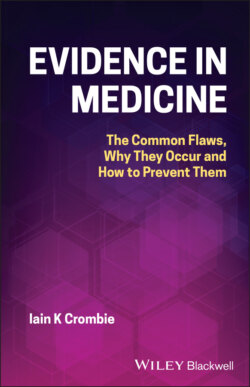Читать книгу Evidence in Medicine - Iain K. Crombie - Страница 11
COMPARING SIMILAR GROUPS
ОглавлениеWhen groups are similar at baseline, it is more likely that any differences in subsequent outcomes will be due to the differences in the effects of the treatments. The idea of comparing like with like was proposed in the fourteenth century by the poet Francisco Petrarch, who suggested using similar groups of patients to compare the then current treatments with simply letting nature take its course [26].
One way to create similar groups is to recruit a number of patients who are all alike, then give them different treatments. The testing of potential treatments for scurvy is a widely cited example of the benefit of using similar groups. Scurvy is a debilitating and sometimes fatal disease, which afflicted sailors on long‐distance sea voyages from the fifteenth to the nineteenth centuries [27, 28]. By the late 1500s, the benefits of consuming oranges and lemons were well known by Dutch sailors [27], but many English expeditions continued to suffer serious loss of life through scurvy [28]. The issue was still unresolved in 1747 when James Lind, a Royal Navy surgeon, carried out a classic study to assess the effects of six common treatments. He identified 12 sailors with scurvy who were ‘as similar as I could have them’, and tested each of the treatments on groups of 2 men (each pair to receive either: oil of vitriol, vinegar, sea water, cider, oranges and lemons, or a herbal paste) [29]. After 14 days Lind observed ‘the most sudden and visible good effects were perceived from the use of oranges and lemons’. These findings were not widely accepted, and even Lind had doubts about them [29, 30], but the method used reflects an advance in thinking about ways to test treatments. Lind is rightly celebrated for his comparison of like with like in the evaluation of treatments. (In his ‘Treatise of the Scurvy’ Lind does not make any clear recommendations for the treatment of the disease, possibly because he believed that scurvy was not due to poor diet, but was a result of faulty digestion exacerbated by wet weather [29, 30].)
Another study in the eighteenth century used similar groups to assess whether the adverse effects of variolation (to prevent smallpox) could be ameliorated by pretreatment with a compound of mercury. At that time about 1 out of 50 patients vaccinated against smallpox died following the procedure [31]. In 1767 William Watson recruited 31 children who were similar in age, gender and diet [32]. These were divided into three groups, which received either the mercury mixture, a mild senna laxative or no treatment. No clear difference was found between the groups, using an objective measure of assessment (the number of pock marks caused by the variolation). Watson concluded that variolation against smallpox was effective with or without pretreatment with mercury or a mild laxative [32].
